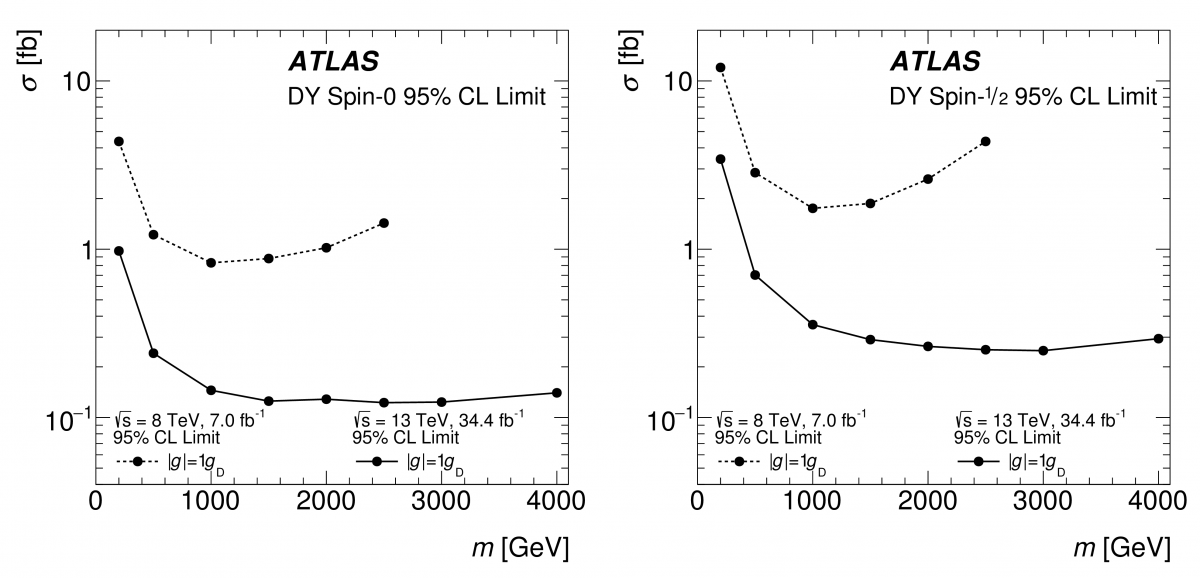ATLAS releases new result in hunt for mysterious magnetic monopoles
3 June 2019 | By

Dipole magnets are probably the best-known source of magnetic fields. They consist of a north and south pole; while one end magnetically attracts, the opposite repels. If you cut a magnet in half, you are left with two magnets, each with its own north and south pole. This apparent absence of an isolated magnetic pole – or “magnetic monopole” – has puzzled physicists for more than a century. It would seem perfectly natural for this particle to be present in our universe; Maxwell’s equations would reflect complete symmetry between electricity and magnetism if particles with magnetic charge were observed. So far the mystery remains: while every known particle in our universe is either electrically charged or neutral, none have been found to be magnetically charged.
In 1931, Paul Dirac was the first to formally propose a theory for magnetic monopoles, which might be produced in conditions like the ones found at the LHC. Scientists from the ATLAS Collaboration have designed a specialised technique to search for evidence of such particles. According to Dirac, magnetic monopoles of fundamental magnetic charge (1 gD) ionise matter the same way a high-electric-charge object (HECO) would. Large energy deposits, proportional to the charge squared would be left behind in the ATLAS detector where these particles travelled through.
Thus, a search for magnetic monopoles with these characteristics goes hand in hand with a search for stable particles of many times (more than 20) the charge of the electron. ATLAS physicists pick out collision events with characteristics expected of HECOs or magnetic monopoles from data collected by ATLAS’ tracking detector and calorimeter systems for further analysis. These candidate events are identified by discriminating regions with large and narrow energy depositions in the calorimeter and corresponding traces of high ionisation in the transition-radiation tracker.
Scientists from the ATLAS Collaboration designed a specialised technique to search for particles with a funadamental magnetic charge ("magnetic monopoles").
Last week, the ATLAS Collaboration released its first results from the search for magnetic monopoles and HECOs in 13 TeV proton-proton collisions. Given that no evidence of either magnetic monopoles or HECOs was observed, constraints were established on spin-0 and spin-½ particles assuming the Drell-Yan electromagnetic pair production mechanism.
To date, the search is the most sensitive study on magnetic monopoles in the range of 1 to 2 gD magnetic charge, surpassing the results of the dedicated MoEDAL experiment, which nonetheless probes a larger range. The study also improves, by approximately a factor of five, the previous constraints on the direct production of magnetic monopoles with magnetic charge 1 gD (see figure). Moreover, it is the first search to study HECOs with charges greater than 60 times the charge of the electron, thereby exceeding the ranges covered by previous CMS and ATLAS studies.
ATLAS has once more proven to be a powerful instrument for scientific study. Through its general purpose detecting capabilities, physicists will be able to continue hunting for exotic particles like the magnetic monopole.
Links
- Search for magnetic monopoles and stable high-electric-charge objects in 13 TeV proton-proton collisions with the ATLAS detector (arXiv:1905.10130, see figures)
- The Hunt for the Truest North, Symmetry Magazine
- The search for magnetic monopoles, Physics Today
- See also the full lists of ATLAS Conference Notes and ATLAS Physics Papers.



